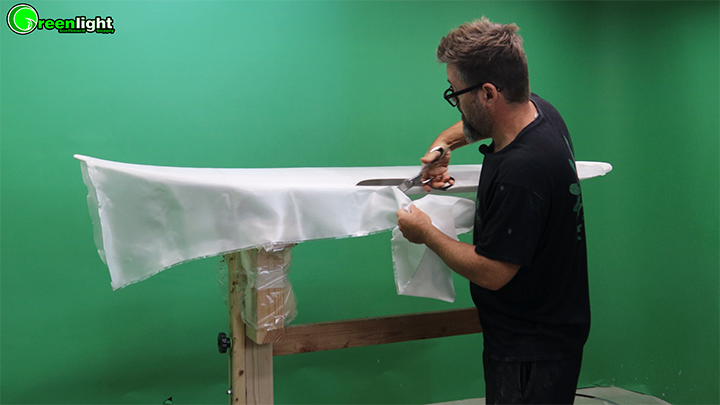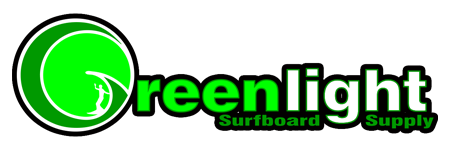
Difference Between Epoxy and Fiberglass Surfboards
At Greenlight, we’ve been educating surfers on every aspect of building and repairing their own surfboards since 2005… and there’s some vocabulary (and misconceptions) we need to clear up for those who might be searching for a little expert help to understanding the basics of surfboard construction.
We know what you mean when saying fiberglass surfboard or epoxy surfboard but what do you call a polyurethane foam blank glassed with epoxy resin??? That’s also a popular surfboard construction but you probably don’t know that if you’re misinformed about surfboard vocabulary… but this article will set you straight and help understand the pros and cons of each type of surfboard construction.
We often hear (way to often) “I need fiberglass resin to repair my board” or “I want to make a fiberglass surfboard”... There is no such thing as fiberglass resin or a fiberglass surfboard!
THERE IS RESIN - a liquid plastic that cures hard over time to bond fiberglass to the foam core and make it waterproof. Resin can be polyester resin, epoxy resin, or vinylester resin.
THERE IS FIBERGLASS - Technically it’s fiberglass cloth. In the case of surfboards the fiberglass cloth is made of woven glass strands that protects the foam from core from damage and provides stiffness to the surfboard.
Let’s add another term to this mix for complete understanding:
COMPOSITE - A composite by definition is a combination of components that when bonded together create a stronger item than as individual components.
Surfboards are composite structures… Foam, fiberglass cloth, and resin all joined together to form a lightweight and relatively strong piece of equipment we love to ride waves with.
Also worth mentioning is the process of applying fiberglass cloth and resin to a shaped surfboard foam blank is called “glassing” - short for fiberglassing.
An “un-glassed” foam surfboard blank without the reinforcement of fiberglass cloth or resin will certainly snap in half at some point when trying to ride waves with it. A foam blank wrapped in fiberglass cloth and no resin will do the same. There is no composite structure going on yet. Fiberglass cloth without resin is useless (unless being used as insulation against heat or electricity). Similarly a foam surfboard blank “glassed” with only resin will take a bit more force to break due to the cured resin molecules cross-linking and providing some tensile and compressive strength but will certainly break…
So, we need to build a composite of foam, fiberglass cloth, and resin to make surfboards we can actually stand on and ride waves.
Now, let’s clear up the misinformation that has been adopted by some about the difference between fiberglass surfboards and epoxy surfboards.
Once again, there is no such thing as a fiberglass surfboard or an epoxy surfboard!
To start, all surfboards are glassed with fiberglass cloth. So let's squash that “fiberglass surfboard” misnomer right now. We know what you mean but the correct terminology is a PU/PE (Polyurethane Foam / Polyester Resin) surfboard.
A PU/PE surfboard has been the traditional construction since the 1940’s and still popular today. In a PU/PE construction a polyurethane foam core is glass with fiberglass cloth and polyester resin to make a surfboard.
Since the 1980’s epoxy resin has been used to glass surfboards and increase their durability and performance. Back then, more innovative surfboard builders replaced polyester resin with epoxy resin on PU foam cores but the results were less than optimal due to epoxies being rather new and underdeveloped at the time. Basically boards were heavier and not as good looking as traditional PU/PE constructions… to lessen the weight some manufacturers used super light weight EPS foam cores and glassed them with epoxy resins. Surftech was one of the first brands to do this on a large scale and at that point the term “Epoxy surfboards” was coined. Epoxy surfboards were also known as “pop-out” surfboards as they were made overseas and not hand shaped by molded shapes. These early EPS/Epoxy surfboards were actually too light and stiff and some say felt like surfing a ping pong ball which gave epoxy surfboards a bad reputation. Today when people refer to EPS/Epoxy Surfboards as “Epoxy Surfboards” they equate them to pop-out boards. But this is certainly not the case. Over the years EPS foam and epoxy resin technology (specifically Greenlight’s Engineered EPS foam blanks and Marine Grade Epoxy Resin) have drastically improved as well as shapers’ understanding of the the different flex properties and dynamics of the EPS/epoxy construction so “Epoxy Surfboards” now perform similarly or better than PU/PE or “Fiberglass Surfboards” and is a popular construction method for small wave boards by most surfboard manufacturers.
